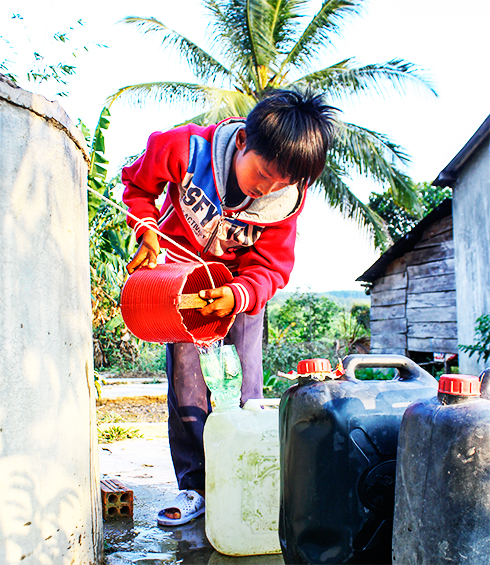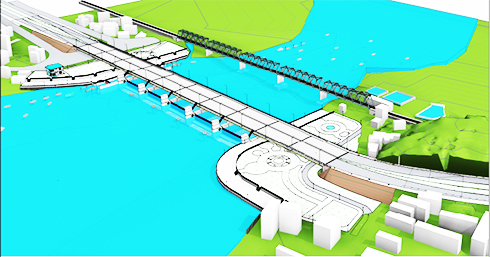
100% of the rural population will have access to hygienic water, 70% to standard clean water by 2025; and 90% to standard clean water by 2035, according to the provincial project approved by Khanh Hoa People's Committee in 2016 on clean water and environmental hygiene in rural areas...
100% of the rural population will have access to hygienic water, 70% to standard clean water by 2025; and 90% to standard clean water by 2035, according to the provincial project approved by Khanh Hoa People’s Committee in 2016 on clean water and environmental hygiene in rural areas.
94% of population with access to hygienic water
The rapid urbanization and socio-economic growth have resulted in mechanical population increase and then sharp rise in water demand. According to the monitoring and evaluation indicator set for clean rural water supply and environmental sanitation 2015 updated in 2016, there are 97 major water supply constructions and more than 85,000 minor ones in Khanh Hoa; 93.1% of rural population have access to hygienic water, 36.7% to clean water meeting the criteria 02 by the Ministry of Health.

|
In 2017, Khanh Hoa Center for Rural Environmental Hygiene & Clean Water jointly handed 2 modern water filter systems over to 2 schools in Khanh Phu Commune and Lien Sang Commune, Khanh Vinh District. Several clean water supply systems were put into operation and upgraded in Suoi Tien Commune; Tan Lap and Van Thuy villages in Cam Phuoc Tay Commune, Cam Lam District; Ninh Tay Commune, Ninh Hoa Town; Ba Cum Bac Commune, Khanh Son District; and Lien Sang Commune, Khanh Vinh District, contributing to bringing rural people’s access to hygiene water in 2017 to 94%.
Khanh Hoa Center for Rural Environmental Hygiene & Clean Water is currently managing 3 water supply constructions in Dien Son- Dien Dien with a capacity of 2,400m3/ day and night, Dien Dong 800m3 / day and night; Dien Phuoc - Dien Lac - Dien Tho - Dien Hoa 1,450m3 / day and night. At present, two other projects under construction include Dien Loc - Dien Binh - Dien Hoa (1,500m3 / day and night) and Dien Xuan - Dien Lam (1,200m3 / day and night). All the constructions have been effectively operated and users have joined effort in protecting the pipeline as well as followed water bill payment schedules. However, the constructions are facing difficulties due to lack of capital and contractors have to advance capital for the implementation, according to Le Van Hung, Director of Khanh Hoa Center for Rural Environmental Hygiene & Clean Water.
Receiving the construction handed over from Khanh Hoa Center for Rural Environmental Hygiene & Clean Water in 2014, Ninh Hoa Urban Company has repaired and upgraded the distribution pipeline network to serve a twofold increase in water supply users, says Nguyen Thi Binh, Vice-Director of Ninh Hoa Urban Company.
Boosting public participation in funding
According to the approved provincial clean water and environmental hygiene project, 100% of the rural population will have access to hygienic water, 70% to clean water meeting the criteria 02 by the Ministry of Health by 2025; and 90% to clean water meeting the criteria 02 by the Ministry of Health by 2035. According to the project, VND2,020 billion funding is required to achieve the target by 2035. Therefore, it is essential to mobilize funds from various sources such as State budget capital integrated in relevant programs and projects, investment capital from various economic sectors, credit capital, local residents’ contribution; as well as implement synchronous solutions, apply science and technology, train human resources, mobilize the participation of the community, etc.
The total investment capital for the clean water and environmental hygiene in rural areas from now to 2035 is VND2,020 billion (VND647 billion in the period 2016 – 2020, VND435 billion in the period 2021 – 2025 and VND938 billion in the period 2026 - 2035), including VND440 from the State budget, VND851 billion from enterprises, VND646 billion from locals and VND83 billion from other sources. The project also defines targets for water supply in rural areas by 2025 and beyond. Special focus will be put on rural population’s access to safe water which is regularly supervised by the Ministry of Health. Solutions include upgrading the size and capacity of water supply systems; using straw water from irrigational works and rivers to save investment cost; providing safe water supply with reduced the cost, increasing the investment effectiveness, contributing to specializing water supply in rural areas.
Clean water constructions have met funding difficulties. Therefore, apart from the integration of State budget capital in programs and projects related to clean water and environmental sanitation in rural areas (new rural construction program, program 134 on providing housing and farming land for ethnic minority people; loans under Decision 62 on credit for the implementation of the national strategy for clean water supply and environmental sanitation in rural areas; Decision 131 on investment preference and promotion policies and the management and exploitation of rural clean water supply works, ODA and so on.). It is necessary to mobilize funds from various sources together with some incentives on land use, taxation and support for individuals and organizations involved in water supply works in rural areas, says Le Tan Ban, Director of Khanh Hoa Department of Agriculture & Rural Development.
V.Lac
Translated by N.T










